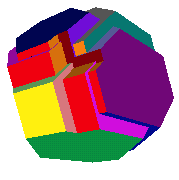Universität Bielefeld
Fakultät für Mathematik
Welcome from
216.73.216.159
Localtime is 07:54:25
Achim

2. Dan
- Location:
- 8°29'37.5"E 52° 2'20"N 147m
- Timezone: Middle European (Summer) Time
- UTC+2 == MEST: -- 1. Apr* - 31. Oct+
- UTC+1 == MET : -- 1. Nov* - 31. Mar+
- * precisely: last Sunday in previous month
- + precisely: last Sunday in this month
- Address:
- Achim Flammenkamp
Fakultät für Mathematik
Universitätsstraße 25
- Universität Bielefeld
Postfach 100131
33501 Bielefeld
Nordrhein-Westfalen
Germany
Europe
- Email:
- achim@uni-bielefeld.de
- URL:
- http://wwwhomes.uni-bielefeld.de/achim/
- PGP-key ID:
- DAB9090D
- use finger achim@chagall.mathematik.uni-bielefeld.de for my public key book
Own Mathematical Works
Exploring NP-hard problems via branch & bound techniques on computers.
- E.g. in 1981:
Counting special 0-1-matrices
- My first such, hundreds of CPU-hours consuming, project together with
Torsten Sillke.
Further Mathematical Interests
Hobbys
W3 Informations
Miscellany
Known Sociable groups Look at David Moews's
Page or Jan M. Pedersen's Page for more information or at the progress in aliquot sequence computations.
Look at David Moews's
Page or Jan M. Pedersen's Page for more information or at the progress in aliquot sequence computations.
Münzenprägen ist ein altes 2 Personenspiel, das seinen Ursprung in China hat. Man muß abwechselnd eine ganze Zahl > 1 ansagen. Dabei sind solche Zahlen ausgeschlossen, die sich als Summe bereits genannter
Zahlen darstellen lassen. Verloren hat der Spieler, der keine Zahl mehr ansagen
kann. Eine vorzügliche Darstellung findet sich in Winning Ways for Your Mathematical Plays, E.R.Berlekamp, J.H.Conway, R.K.Guy (1982) Deutsche Ausgabe: Gewinnen - Strategien für mathematische Spiele Band 3, Kapitel 5, S. 149, Vieweg, 1986. Siehe auch neuere Ergebnisse
Primequads or How I got in contact with computer science
As a fifteen year old boy, I found in school a foreign assembler program on
dash cards which contained about 100 asm statments for an antic deskcalculator
called MONROE, if I remember right. When I succeeded to decypher this code I recognized its sense:
Generating the list of primequads. A primequad is a sequence of four
successive primes with minimal distance. Because of divisibilty by 2,3,5
such a quad must be of the form 30n+11, 30n+13, 30n+17, 30n+19, except the first
primequad 2,3,5,7. The list continues with n = 0,3,6,27,49,62,69,108,115 ... . Like the
primetwin conjecture there is one for the frequency of primequads. See:
An Introduction to the theory of numbers, G.H. Hardy and E.M. Wright, Oxford 1979, 5. Edition
Diese Arbeit über Wartewerte wurde von Torsten Sillke 1983 angeregt:
Betrachte eine unendliche Folge von Buchstaben aus einem n-elementigen Alphabet A.
Jeder Buchstabe soll unabhängig und mit Wahrscheinlichkeit 1/n in dieser Folge
an Position i stehen. Lege nun ein festes Wort endlicher Länge an den Anfang dieser Folge und frage nach der durchschnittlichen Verschiebung längs der Folge bis
das Wort zum ersten Mal auftritt. Dies bezeichnet den Wartewerte dieses Wortes. Der Autokorrelationsstring als Zahl zur Basis n interpretiert,
ergibt genau diesen Wert. Nun stellt sich die Frage, welche Wartewerte/Autokorrelationsstrings für feste Länge k können überhaupt auftreten. Eine rekursive Charakterisierung dieser Werte macht keine Schwierigkeiten, wohl aber ihre genaue Anzahlbestimmung. Asymptotisch wächst ihre Anzahl wie eC ln2 n mit C = 1/ln(4). Eine gute Einführung ist: Periods in Strings,
L.J. Guibas and A.M. Odlyzko, Journal of Combinatorial Theory, Serie A 30, p.19-42 (1981).
The number of intersection points of the diagonals of regular n-gons was
calculated 1979-1980 by me. Surprisingly, this number is a polynom of fourth degree in
n, n mod 2, n mod 6, n mod 30 and n mod 7*360. I must admit, that I found only the correct formulae, but didn't
proof them. Shortly afterwards, I got knowledge of the existence of G. Bol's article in
Nieuw Archief voor Wiskunde 18 (1936). About two years later I
got acess of this paper and my interest on this topic was satisfied. Luckily,
I discovered 1995 an article in the WEB with a exact discussion of
this topic again. So I need not to write down the whole story again,
but can point you to B. Poonen's and M. Rubinsteins's paper.
Here you can fetch it as compressed PS-file with all the diagramms.
What's  that?
that?
Based on an idea of Christian Zylka, FH-Erfurt,
Peter Serocka and I constructed this interesting body 1994. It describes the balance of
four fluids in communicating tubes, if two of them can be pairwise balanced.
Here are a few more VRML-objects.
Sorry, still
to
document:
- Computing the Area of the Mandelbrot Set. Have a look at What is known
- Quickestsort or How to Select the Sort Key Optimal
- Extremal Polyeder in R3
- Bijective Rotation of Z2
- The Analytic Approximation to the Exponential Iterated
My Employee Page |
My Ex-Employee Page |
Mail to Me
I hope you were pleased with visit no 27736
since June 1997.
 GNU Copyleft © 1995-2004 Achim Flammenkamp
GNU Copyleft © 1995-2004 Achim Flammenkamp
Last update: Bielefeld, den 2025-09-21 22:58:16 Uhr.